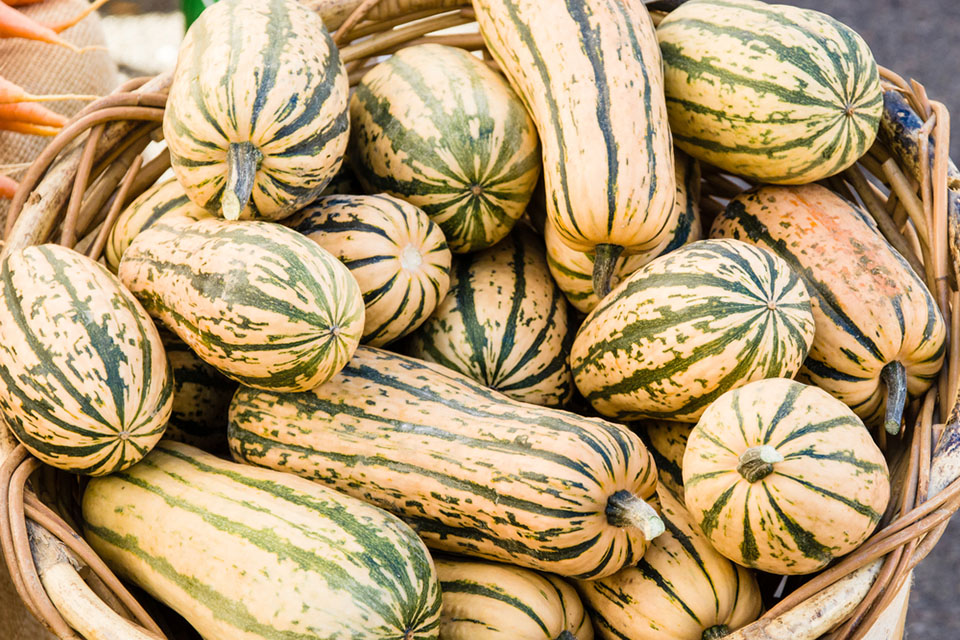Try delicata, an heirloom squash experiencing a dramatic revival thanks to the richer flavor and softer skin of a productive variety that first hit seed markets about a decade ago.

This fall, there is a way to avoid the butternut sinkhole. Try delicata, an heirloom squash experiencing a dramatic revival thanks to the richer flavor and softer skin of a productive variety that first hit seed markets about a decade ago.
Technically a summer squash (Cucurbita pepo), delicata is generally classed with winter squash because it is hard-fleshed and harvested late in the year, but boasts summer squash skin, which is tender enough to remove easily with a vegetable peeler. Also known as “sweet potato squash” for its brown sugar flavor, delicata tastes like a cross between fresh corn and pumpkin pie. Like all hard squash, delicata is high in beta-carotene and vitamin C, relatively low in calories and astonishingly versatile.
With a name like delicata, though, it must be hard to grow, right? Not so.
With a name like delicata, though, it must be hard to grow, right? Not so. Plant it in the summer, and the squash will be ready to harvest after 80 to 100 days in full sun, when the cream-colored skin begins to develop irregular dark-green stripes, like someone has painted the vegetable with an unsteady hand. Unfortunately, delicata is less hardy than other varieties; whereas butternut may be stored up to a year, delicata keeps for just two to three months in a cool, dry place. As delicata ages, the skin develops a deeper orange hue between the stripes, so look for squash with light-colored skin that’s relatively heavy for its size. In general, steer clear of any winter squash that is soft or wrinkled.
According to Kerry Gawalt, owner of Cedar Mountain Farm in Vermont, delicata squash should be harvested in the fall, cured in a warm spot for two weeks, inspected for cuts and then wiped with a mild Clorox solution. “We then store the squash in a 55- to 60-degree room until December,” she says.
First introduced in 1894, the delicata has a shorter shelf life – and smaller yield – that made it less commercially viable than hardier winter squash like butternut, and as a result, delicata was nearly lost during the Great Depression. When scientists at Cornell University bred a more compact, disease-resistant bush variety about 10 years ago, delicata began making a comeback. Now, it is much more widely available at farmers markets, where its flavor has inspired die-hard devotion.
So, welcome back, delicata! Consider the butternut oligarchy squashed.

Photo credit: James Ransom, www.Food52.com
Hard Squash Hummus

This recipe is adapted from a dish served at the San Francisco restaurant Bar Tartine, where chef Nicolaus Balla tops roasted and pureed butternut squash with sunflower sprouts, curried yogurt, cilantro puree, and pomegranate molasses. The toppings suggested here are somewhat simpler – creativity is encouraged. This recipe serves a crowd, but freezes well. Yield: 5 to 6 cups.
- 2 pounds hard squash, such as delicata or butternut
- 1 cup plus two tablespoons extra-virgin olive oil ( )
- salt and pepper
- 2 heads garlic, separated into cloves and peeled ((about ½ cup cloves))
- 2 or 3 serrano peppers, sliced in half, stems and seeds removed
- ¼ cup tahini
- 3 tablespoons lemon juice
- Plain yogurt for garnish ((optional))
- Cilantro leaves for garnish ((optional))
- Roasted pumpkin seeds for garnish ((optional))
- Crusty bread, pita, or crackers
-
Preheat the oven to 350 F. Cut squash in half and remove seeds. Rub flesh with 2 tablespoons olive oil and 2 generous pinches salt.
-
Place squash cut side down in roasting pan and bake until very soft, about 1 hour.
-
While squash is baking, place garlic, serranos and remaining olive oil in small pot over low heat. Poach garlic and peppers in oil until completely soft (30 to 40 minutes). Garlic should be very lightly browned.
-
Scoop out flesh from roasted squash and place in food processor. Add garlic-poaching olive oil, garlic, serranos, tahini and lemon juice. Puree until smooth, about 1 minute. Season to taste with salt and pepper.
-
Hummus texture will vary depending on squash variety and size; add up to ½ cup water until desired consistency is reached. Refrigerate for at least 3 hours and up to 1 week.
-
For 1 cup hummus, garnish with ¼ cup yogurt, 1 tablespoon pumpkin seeds and sprinkling of cilantro leaves. Serve with crusty bread, pita or crackers.
By growing up a fence and using very fine misters, I am able to get flowering and large fruiting with temps above 100f. Beautiful and delicious.